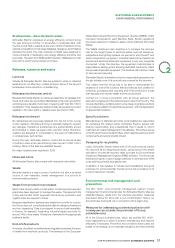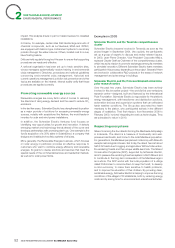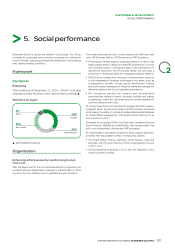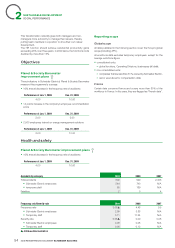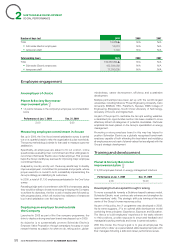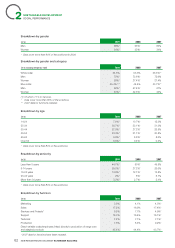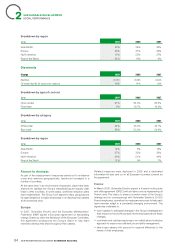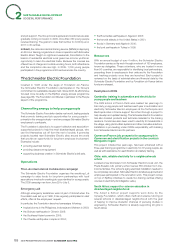APC 2009 Annual Report Download - page 60
Download and view the complete annual report
Please find page 60 of the 2009 APC annual report below. You can navigate through the pages in the report by either clicking on the pages listed below, or by using the keyword search tool below to find specific information within the annual report.
2009 REGISTRATION DOCUMENT SCHNEIDER ELECTRIC58
SUSTAINABLE DEVELOPMENT
2SOCIAL PERFORMANCE
Training (France)
Main topics
(in % costs) 2009 2008 2007
Health, safety, environment 11.5 % 10% 8.7%
Technical 18.1 % 12.5% 17.3%
Foreign languages and IT 7.1 % 18.8% 13.4%
Management and leadership 25 .6 % 21.5% 13.7%
Manufacturing 13 .1% 10.7% 9.6%
Breakdown
(in % costs) 2009 2008 2007
By gender -
Women 25.0% 27.2% 32%
Men 75.0% 72.8% 68%
By category -
Engineers and managers 45.6% 42.5% 33%
Supervisors, administrative and technical staff 38.4% 34.5% 38%
Line employees 16.0% 23.0% 29%
Performance as an integral part of human resources
policy
Schneider Electric’s strategy hinges on continuously monitoring
and developing its employee base of several thousands of people
worldwide, while also identifying new talent, particularly in new
economies.
The global Talent Acceleration programme is designed to increase
the Group’s talent pool and develop its diversity, in accordance with
the One Schneider Electric company programme .
In 2009, this programme focused primarily on new economies, but
also worked to sharpen managerial abilities to effectively identify and
nurture the highest performing employees.
To this end, performance management tools were deployed at all
levels of the organisation . These include individual skills reviews,
annual performance appraisals, mid-year reviews to assess progress
and adjust targets, and “people reviews”. All of these resources help
the Group continuously monitor and accurately evaluate individual
and collective performance and identify high potentials.
The use of these tools has made for more objective and individualized
decisions concerning career management, compensation and
recognition.
In 2009, a group-wide mentoring programme was set up to facilitate
employees’ professional and personal development, expose them
to real-life management situations, promote a learning culture in the
front lines and encourage experience sharing.
Diversity
Employees who feel respected are more motivated and effective.
For this reason, Schneider Electric has taken measures to promote
gender equality, age diversity, jobs for the disabled and minority
hiring. The Group takes action at three levels: recruitment, job
opportunities for young people and career development.
Schneider Electric’s goal is to make diversity a strength, an advantage
and lever for developing creativity and competitiveness. Its diversity
charter refl ects this commitment. Particular emphasis is placed on
including women at all levels of the Company.
Gender diversity
Schneider Electric strongly believes that diversity—and gender
diversity in particular—is a key driver of innovation, performance
and profi tability.
The Group’s objective is to hire and foster the best talent while
meeting the major challenges of the 21stcentury, chief among
them the constantly growing need for clean energy. This implies
recognising women and placing them in important roles in the
community and the business world.
Accordingly, Schneider Electric is committed to promoting
diversity within all its teams. That commitment starts with building
management teams that reflect the diversity of the Group’s
customers and end users as much as possible.
In 2009, the Group worked to raise awareness among both male and
female managers about the competitive and strategic advantages
of gender diversity.
An awareness programme supported by an e-learning module was
deployed to all the Group’s Management Committees in a sweeping
initiative to address these issues. In 2010, this training module will
be made available to all Group employees. Having a better grasp
of how gender diversity affects the workplace will help Schneider
Electric to adjust to 21stcentury society, especially to the needs of
the Y generation, which is eager to reconcile work and family life.
Today at Schneider Electric, women serve as Country Organisation
managers in the United States, Germany, Brazil, Taiwan and Western
Africa.
In 2009, the Group was awarded France’s workplace equality label
for the third consecutive year.





